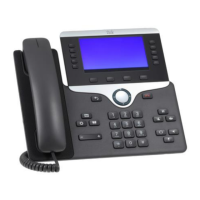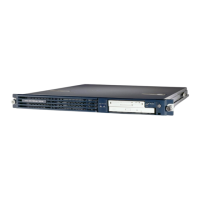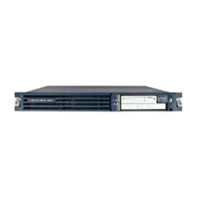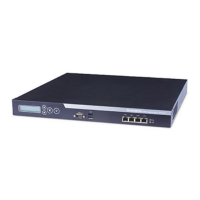Network Configuration Page: 117 About Network Configuration Describes the appearance of the Network Configuration page and the tables that may appear, such as AAA Clients, AAA Servers, and Network Device Groups.
About Distributed Systems Explains how Cisco Secure ACS can be used in a distributed system with multiple ACSes communicating with each other.
Proxy in Distributed Systems Details the proxy feature, enabling Cisco Secure ACS for authentication in networks with multiple AAA servers and character string matching.
Network Device Searches Describes how to search for any network device configured in the Network Configuration section.
AAA Client Configuration Provides procedures for configuring AAA clients, including options for hostname, IP address, key, network device group, and authentication method.
AAA Server Configuration Details procedures for configuring AAA servers, including name, IP address, key, network device group, log options, and server type.
User Management Page: 247 About User Databases Details the various databases used for user authentication, including CiscoSecure and external databases like Windows, LDAP, Novell NDS, ODBC, and Token Servers.
Basic User Setup Options Presents basic activities for configuring a new user, including specifying name, external database/password, and submitting information.
User Management Describes how to use the User Setup section to perform user account managerial tasks like listing, finding, disabling, and deleting users.
System Configuration: Basic Page: 307 Service Control Provides basic status information about services and enables stopping, starting, or restarting them.
Logging Explains how to configure Cisco Secure ACS to generate logs for administrative and accounting events.
Date Format Control Allows selection between two date formats (month/day/year or day/month/year) for logs, reports, and the administrative interface.
Local Password Management Configures settings for managing passwords stored in the CiscoSecure user database, including validation and remote change options.
Cisco Secure ACS Backup Provides information about the Cisco Secure ACS Backup feature, including manual and scheduled backups, options, and file locations.
System Configuration: Advanced Page: 329 CiscoSecure Database Replication Covers CiscoSecure Database Replication, including process, frequency, implementation, configuration of secondary ACS, replication options, and event errors.
RDBMS Synchronization Provides information on implementing RDBMS Synchronization, including components, considerations, CSV-based sync, data source name, and options.
IP Pools Server Explains the IP Pools feature, including creating, maintaining, allowing overlapping pools, refreshing tables, and recovering addresses.
IP Pools Address Recovery Details the IP Pools Address Recovery feature, enabling recovery of assigned IP addresses not used for a specified period.
Logs and Reports Page: 433 Logging Formats Describes the two formats for logging data: CSV files and ODBC-compliant database tables.
Special Logging Attributes Explains special logging attributes like User Attributes, ExtDB Info, Access Device, Network Device Group, Filter Information, Device Command Set, and Remote Logging Result.
NAC Attributes in Logs Discusses posture validation attributes used by NAC that can be logged, including Application-Posture-Token and System-Posture-Token.
Working with CSV Logs Provides instructions on configuring CSV logs, including file names, locations, enabling/disabling, viewing reports, and log content.
Working with ODBC Logs Details how to prepare for ODBC logging, configure system data source names, and configure individual ODBC logs.
Remote Logging Discusses remote logging capabilities, including implementing centralized logging, options, and enabling/disabling remote logging.
Service Logs Explains service logs as diagnostic tools for troubleshooting and debugging, containing records of all service actions and activities.
Administrators and Administrative Policy Page: 467 Administrator Accounts Provides details about Cisco Secure ACS administrators, including accounts, privileges, adding, editing, unlocking, and deleting accounts.
Access Policy Affects access to the Cisco Secure ACS HTML interface, allowing limits by IP address, TCP port range, and SSL enablement.
Session Policy Controls administrative sessions, including idle timeout, automatic local login, response to invalid IP, and administrator lockout.
Audit Policy Controls the generation of the Administrative Audit log.
User Databases Page: 485 CiscoSecure User Database Describes the internal Cisco Secure ACS database, supporting various authentication methods and crucial for the authorization process.
About External User Databases Explains how to configure Cisco Secure ACS to forward authentication to external databases, leveraging existing user data.
Windows User Database Details support for Windows external user databases, including user authentication, machine authentication, group mapping, and password aging.
Generic LDAP Covers support for generic LDAP authentication, including instances, organizational units, groups, domain filtering, and failover.
Novell NDS Database Explains support for Novell NetWare Directory Services (NDS) servers for user authentication and group mapping.
ODBC Database Details support for ODBC-compliant relational databases, including authentication, group specification, and stored procedures.
Token Server User Databases Explains support for token servers for one-time password (OTP) authentication, including RADIUS-enabled and RSA SecurID servers.
Network Admission Control Page: 573 NAC AAA Components Defines the components of the NAC AAA paradigm: NAC-client computer, AAA client, Cisco Secure ACS, NAC server, and Remediation server.
Posture Validation Describes how Cisco Secure ACS determines computer posture using credentials, steps involved, and how it derives application posture tokens.
Posture Tokens Explains posture tokens representing computer state, including system and application posture tokens, and predefined non-configurable tokens.
NAC Databases Covers NAC databases, including their purpose, components, configuration options, and policy selection.
NAC Policies Explains how Cisco Secure ACS applies policies to validation requests based on selected NAC database policies.
APPENDIX A Troubleshooting Page: 645 Administration Issues Lists common conditions related to remote administrator access to the HTML interface and their recovery actions.
Browser Issues Details common browser issues that affect the Cisco Secure ACS HTML interface, such as Java messages and proxy configurations.
Cisco IOS Issues Addresses issues related to Cisco IOS commands, RADIUS attributes not supported, and enable mode errors.
Database Issues Covers problems with RDBMS Synchronization, Database Replication, and external user databases not being available.
Dial-in Connection Issues Addresses issues preventing dial-in users from connecting to AAA clients, including configuration and database problems.
Debug Issues Explains recovery actions for failure messages when running debug aaa authentication on AAA clients.
Proxy Issues Covers recovery actions when proxying requests to another server fails, including shared secret and character string matching.
MaxSessions Issues Covers problems with MaxSessions over VPN or unreliable user MaxSessions values and provides recovery actions.
Report Issues Addresses issues with reports being blank, missing unknown user information, or duplicate entries for user sessions.
Third-Party Server Issues Covers issues with implementing RSA token servers and authentication requests not hitting external databases.
User Authentication Issues Addresses problems with user authentication, including failure messages, incorrect configurations, and timeout issues.
Internal Architecture Page: 825 Windows Services Describes the modular service modules of Cisco Secure ACS, including CSAdmin, CSAuth, CSDBSync, CSLog, CSMon, CSTacacs, and CSRadius.
Windows Registry Indicates the location of Cisco Secure ACS information in the Windows Registry and advises against modification.
CSAdmin Explains CSAdmin as the service providing the web server for the Cisco Secure ACS HTML interface.
CSAuth Describes CSAuth as the authentication and authorization service, managing user access and defining privileges.
CSDBSync Explains CSDBSync as the service for synchronizing the Cisco Secure ACS database with third-party RDBMS systems.
CSLog Details CSLog as the service for capturing and placing logging information into CSV files.
CSMon Describes CSMon as a service for minimizing downtime by monitoring system parameters and application performance.
Monitoring Explains how CSMon monitors overall system status and key system parameters like disk space and processor utilization.
Recording Describes how CSMon records exception events in logs for diagnosing problems.
Notification Details how CSMon can be configured to notify system administrators of exception events, responses, and outcomes.
Response Explains how CSMon detects exception events and responds by logging, sending notifications, or taking actions.
CSTacacs and CSRadius Describes how CSTacacs and CSRadius services communicate between CSAuth and access devices for authentication and authorization.
Network Configuration Page: 117 About Network Configuration Describes the appearance of the Network Configuration page and the tables that may appear, such as AAA Clients, AAA Servers, and Network Device Groups.
About Distributed Systems Explains how Cisco Secure ACS can be used in a distributed system with multiple ACSes communicating with each other.
Proxy in Distributed Systems Details the proxy feature, enabling Cisco Secure ACS for authentication in networks with multiple AAA servers and character string matching.
Network Device Searches Describes how to search for any network device configured in the Network Configuration section.
AAA Client Configuration Provides procedures for configuring AAA clients, including options for hostname, IP address, key, network device group, and authentication method.
AAA Server Configuration Details procedures for configuring AAA servers, including name, IP address, key, network device group, log options, and server type.
User Management Page: 247 About User Databases Details the various databases used for user authentication, including CiscoSecure and external databases like Windows, LDAP, Novell NDS, ODBC, and Token Servers.
Basic User Setup Options Presents basic activities for configuring a new user, including specifying name, external database/password, and submitting information.
User Management Describes how to use the User Setup section to perform user account managerial tasks like listing, finding, disabling, and deleting users.
System Configuration: Basic Page: 307 Service Control Provides basic status information about services and enables stopping, starting, or restarting them.
Logging Explains how to configure Cisco Secure ACS to generate logs for administrative and accounting events.
Date Format Control Allows selection between two date formats (month/day/year or day/month/year) for logs, reports, and the administrative interface.
Local Password Management Configures settings for managing passwords stored in the CiscoSecure user database, including validation and remote change options.
Cisco Secure ACS Backup Provides information about the Cisco Secure ACS Backup feature, including manual and scheduled backups, options, and file locations.
System Configuration: Advanced Page: 329 CiscoSecure Database Replication Covers CiscoSecure Database Replication, including process, frequency, implementation, configuration of secondary ACS, replication options, and event errors.
RDBMS Synchronization Provides information on implementing RDBMS Synchronization, including components, considerations, CSV-based sync, data source name, and options.
IP Pools Server Explains the IP Pools feature, including creating, maintaining, allowing overlapping pools, refreshing tables, and recovering addresses.
IP Pools Address Recovery Details the IP Pools Address Recovery feature, enabling recovery of assigned IP addresses not used for a specified period.
Logs and Reports Page: 433 Logging Formats Describes the two formats for logging data: CSV files and ODBC-compliant database tables.
Special Logging Attributes Explains special logging attributes like User Attributes, ExtDB Info, Access Device, Network Device Group, Filter Information, Device Command Set, and Remote Logging Result.
NAC Attributes in Logs Discusses posture validation attributes used by NAC that can be logged, including Application-Posture-Token and System-Posture-Token.
Working with CSV Logs Provides instructions on configuring CSV logs, including file names, locations, enabling/disabling, viewing reports, and log content.
Working with ODBC Logs Details how to prepare for ODBC logging, configure system data source names, and configure individual ODBC logs.
Remote Logging Discusses remote logging capabilities, including implementing centralized logging, options, and enabling/disabling remote logging.
Service Logs Explains service logs as diagnostic tools for troubleshooting and debugging, containing records of all service actions and activities.
Administrators and Administrative Policy Page: 467 Administrator Accounts Provides details about Cisco Secure ACS administrators, including accounts, privileges, adding, editing, unlocking, and deleting accounts.
Access Policy Affects access to the Cisco Secure ACS HTML interface, allowing limits by IP address, TCP port range, and SSL enablement.
Session Policy Controls administrative sessions, including idle timeout, automatic local login, response to invalid IP, and administrator lockout.
Audit Policy Controls the generation of the Administrative Audit log.
User Databases Page: 485 CiscoSecure User Database Describes the internal Cisco Secure ACS database, supporting various authentication methods and crucial for the authorization process.
About External User Databases Explains how to configure Cisco Secure ACS to forward authentication to external databases, leveraging existing user data.
Windows User Database Details support for Windows external user databases, including user authentication, machine authentication, group mapping, and password aging.
Generic LDAP Covers support for generic LDAP authentication, including instances, organizational units, groups, domain filtering, and failover.
Novell NDS Database Explains support for Novell NetWare Directory Services (NDS) servers for user authentication and group mapping.
ODBC Database Details support for ODBC-compliant relational databases, including authentication, group specification, and stored procedures.
Token Server User Databases Explains support for token servers for one-time password (OTP) authentication, including RADIUS-enabled and RSA SecurID servers.
Network Admission Control Page: 573 NAC AAA Components Defines the components of the NAC AAA paradigm: NAC-client computer, AAA client, Cisco Secure ACS, NAC server, and Remediation server.
Posture Validation Describes how Cisco Secure ACS determines computer posture using credentials, steps involved, and how it derives application posture tokens.
Posture Tokens Explains posture tokens representing computer state, including system and application posture tokens, and predefined non-configurable tokens.
NAC Databases Covers NAC databases, including their purpose, components, configuration options, and policy selection.
NAC Policies Explains how Cisco Secure ACS applies policies to validation requests based on selected NAC database policies.
APPENDIX A Troubleshooting Page: 645 Administration Issues Lists common conditions related to remote administrator access to the HTML interface and their recovery actions.
Browser Issues Details common browser issues that affect the Cisco Secure ACS HTML interface, such as Java messages and proxy configurations.
Cisco IOS Issues Addresses issues related to Cisco IOS commands, RADIUS attributes not supported, and enable mode errors.
Database Issues Covers problems with RDBMS Synchronization, Database Replication, and external user databases not being available.
Dial-in Connection Issues Addresses issues preventing dial-in users from connecting to AAA clients, including configuration and database problems.
Debug Issues Explains recovery actions for failure messages when running debug aaa authentication on AAA clients.
Proxy Issues Covers recovery actions when proxying requests to another server fails, including shared secret and character string matching.
MaxSessions Issues Covers problems with MaxSessions over VPN or unreliable user MaxSessions values and provides recovery actions.
Report Issues Addresses issues with reports being blank, missing unknown user information, or duplicate entries for user sessions.
Third-Party Server Issues Covers issues with implementing RSA token servers and authentication requests not hitting external databases.
User Authentication Issues Addresses problems with user authentication, including failure messages, incorrect configurations, and timeout issues.
Internal Architecture Page: 825 Windows Services Describes the modular service modules of Cisco Secure ACS, including CSAdmin, CSAuth, CSDBSync, CSLog, CSMon, CSTacacs, and CSRadius.
Windows Registry Indicates the location of Cisco Secure ACS information in the Windows Registry and advises against modification.
CSAdmin Explains CSAdmin as the service providing the web server for the Cisco Secure ACS HTML interface.
CSAuth Describes CSAuth as the authentication and authorization service, managing user access and defining privileges.
CSDBSync Explains CSDBSync as the service for synchronizing the Cisco Secure ACS database with third-party RDBMS systems.
CSLog Details CSLog as the service for capturing and placing logging information into CSV files.
CSMon Describes CSMon as a service for minimizing downtime by monitoring system parameters and application performance.
Monitoring Explains how CSMon monitors overall system status and key system parameters like disk space and processor utilization.
Recording Describes how CSMon records exception events in logs for diagnosing problems.
Notification Details how CSMon can be configured to notify system administrators of exception events, responses, and outcomes.
Response Explains how CSMon detects exception events and responds by logging, sending notifications, or taking actions.
CSTacacs and CSRadius Describes how CSTacacs and CSRadius services communicate between CSAuth and access devices for authentication and authorization.






